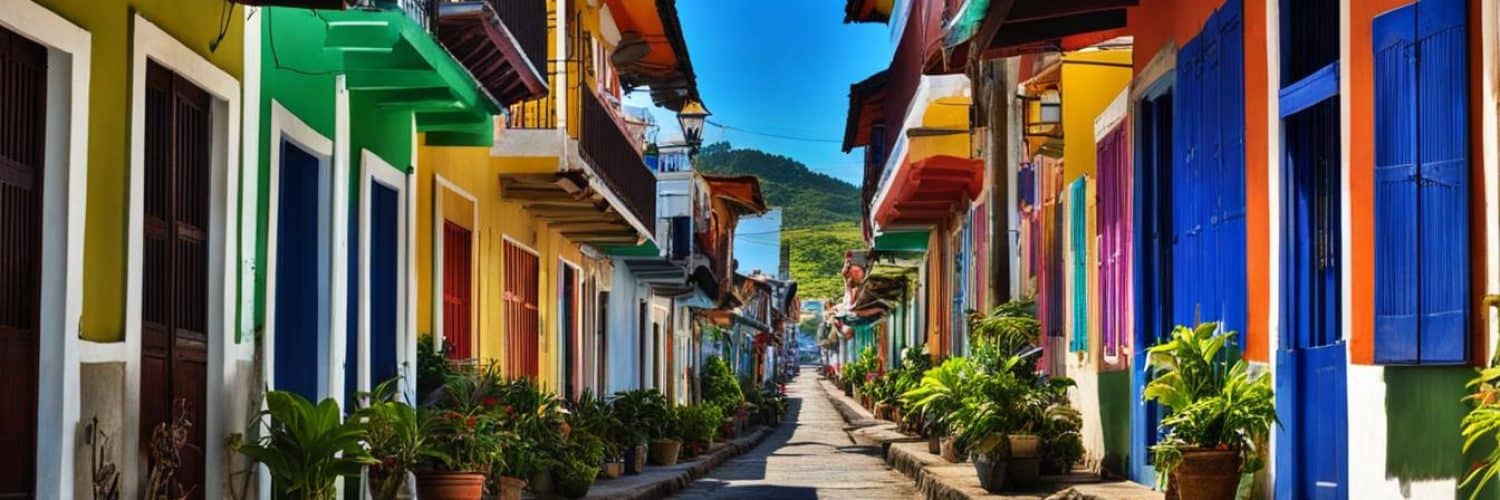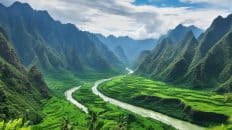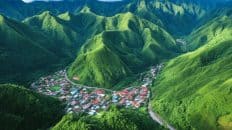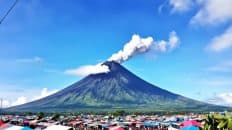Carcar City is a small but vibrant city located in the southern part of Cebu, Philippines. It is known for its rich culture, delicious cuisine, and historical attractions. The city was founded in 1599 and played a significant role in the Spanish colonial era, Philippine Revolution, and World War II. Today, Carcar City preserves its heritage through its architecture, museums, and festivals. Visitors can explore the public market, St. Catherine of Alexandria Church, Carcar Museum, and indulge in famous delicacies like chicharon, lechon, and ampao. The city also celebrates various festivals, including the Kabkaban Festival and Kawayan Festival. Getting to Carcar City is convenient with bus and private car options from Cebu City, and getting around the city can be done by tricycle or on foot. Carcar City offers a unique blend of culture, cuisine, and natural beauty, making it a must-visit destination in Cebu.
Key Takeaways
- Carcar City is a vibrant city in southern Cebu known for its rich culture, cuisine, and historical attractions.
- The city preserves its heritage through architecture, museums, and festivals.
- Visitors can explore the public market, St. Catherine of Alexandria Church, and the Carcar Museum.
- Don’t miss out on trying famous delicacies like chicharon, lechon, and ampao.
- Carcar City hosts various festivals, including the Kabkaban Festival and Kawayan Festival.
- Transportation options include buses and private cars from Cebu City.
- Getting around Carcar City can be done by tricycle or on foot.
History and Heritage of Carcar City
Carcar City, with its rich and colorful history, is a treasure trove of heritage that dates back to the Spanish colonial era. Founded in 1599 by the Augustinian friars, Carcar City quickly became an important trading center in the region, attracting merchants from far and wide. This historical significance is deeply embedded in the city’s architecture, museums, and festivals, providing a glimpse into its captivating past.
During the Spanish colonial era, Carcar City flourished as a valuable trading hub, showcasing a fusion of Spanish and Filipino cultures. The city played a vital role in the Philippine Revolution, with its residents actively participating in the fight for independence against foreign rule. Carcar City also served as a stronghold for the guerrilla movement during World War II, further solidifying its place in history.
The city’s architecture reflects its rich heritage, featuring a mix of Spanish and American colonial influences. From the iconic St. Catherine of Alexandria Church, adorned with intricate details and steeped in history, to the preserved heritage houses like Balay na Tisa, Yap House, and Silva House, Carcar City’s structures stand as testaments to its cultural legacy. Other notable landmarks include the Carcar Rotunda, a symbol of civic pride, and the Carcar Dispensary, a beautiful Spanish-era structure turned museum.
Notable Heritage Sites of Carcar City
| Heritage Site | Description |
|---|---|
| St. Catherine of Alexandria Church | A magnificent Baroque-style church with a fascinating history and stunning architectural details. |
| Balay na Tisa | An ancestral house that showcases the city’s architectural heritage, known for its red-brick walls. |
| Yap House | A well-preserved heritage house built during the Spanish colonial period, offering a glimpse into the city’s past. |
| Silva House | A grand ancestral house that exemplifies the blending of indigenous and colonial architectural influences. |
| Carcar Rotunda | A landmark roundabout that serves as a centerpiece of the city, showcasing its vibrant culture and heritage. |
| Carcar Dispensary | A historical building turned museum, preserving artifacts and showcasing the city’s rich history and cultural heritage. |
Carcar City’s dedication to preserving its history and heritage is further celebrated through its festivals. The city comes alive with vibrant events such as the Kabkaban Festival, showcasing the richness of Carcar’s cultural traditions, and the Kawayan Festival, which highlights the city’s bamboo industry. These festivals offer a unique opportunity to experience the local culture first-hand, with colorful parades, music, and dance.
Carcar City’s commitment to preserving its history and heritage makes it a must-visit destination for those seeking to immerse themselves in the rich tapestry of the Philippines.
Exploring Carcar City’s Attractions
Carcar City is a destination filled with diverse attractions that cater to different interests. Whether you’re a food lover, history enthusiast, or an admirer of architectural beauty, Carcar City has something for everyone. Let’s delve into some of the standout attractions that await you in this charming city.
1. Public Market
The Carcar City Public Market is a bustling hub that showcases the vibrant culture and culinary delights of the city. Housed in a well-preserved heritage building, the market offers a fascinating glimpse into the local way of life. From fresh produce to handicrafts and local delicacies, the market is a treasure trove of flavors, sights, and sounds. Explore the stalls and indulge in mouthwatering treats such as chicharon, ampao, and many more.
2. St. Catherine of Alexandria Church
A visit to Carcar City would not be complete without exploring the historic St. Catherine of Alexandria Church. This architectural gem was built in the 1800s and bears a captivating blend of baroque and neoclassical styles. Marvel at the intricate details of the façade, step inside to admire the ornate interiors, and soak in the tranquil atmosphere. The St. Catherine of Alexandria Church is a testament to the city’s rich religious heritage and is a must-visit attraction for history and architecture enthusiasts alike.
3. Carcar Museum
Immerse yourself in Carcar City’s history and culture by visiting the Carcar Museum. This educational institution showcases a diverse range of exhibits and artifacts that highlight the city’s heritage. Learn about the city’s Spanish colonial roots, the Philippine Revolution, and its contributions during World War II. The Carcar Museum offers a comprehensive journey through time and provides valuable insights into the city’s past.
The combination of the public market, St. Catherine of Alexandria Church, and Carcar Museum gives visitors a well-rounded experience of Carcar City’s rich heritage, culture, and culinary delights. The blend of historical sites, vibrant markets, and informative museums makes Carcar City a fascinating destination for travelers seeking authentic experiences.
Discovering Carcar City’s Culinary Delights
One of the highlights of visiting Carcar City is indulging in its famous delicacies. The city is known for its mouthwatering culinary delights, including chicharon, lechon, and ampao.
Chicharon is a popular snack made from deep-fried pork rind that is crispy and flavorful. It is a beloved treat that locals and tourists can’t resist.
Lechon is a traditional Filipino dish, and Carcar City is known for its succulent and flavorful roasted pig. The lechon in Carcar City is cooked to perfection, with crispy skin and juicy meat that will satisfy any meat lover’s cravings.
Ampao is a local rice crispy treat that is sweet and crunchy. Made from glutinous rice, sugar, and various flavorings, it is a delightful snack that is perfect for satisfying your sweet tooth.
Visitors can sample these delicacies in the public market or at various restaurants and street vendors throughout the city. The carcar delicacies are made with local ingredients and traditional recipes, ensuring an authentic culinary experience.
Exploring Carcar City’s culinary scene is a must for all food enthusiasts. Whether you’re indulging in the crispy goodness of chicharon, savoring the succulent lechon, or enjoying the sweet and crunchy ampao, Carcar City’s culinary delights will leave you craving for more.
Festivals and Events in Carcar City
Carcar City is known for its vibrant festivals and events that showcase its rich culture and traditions. These celebrations offer a unique opportunity for visitors to immerse themselves in the colorful and lively atmosphere of the city.
Kabkaban Festival
The Kabkaban Festival is one of the most anticipated events in Carcar City, held annually on November 24th. This cultural festival is a vibrant spectacle of street dancing, captivating costumes, and energetic music. The festival’s name is derived from the Cebuano word “kabkab,” which means to gather and collect. It symbolizes the unity and gathering of people from all walks of life to celebrate Carcar City’s heritage and culture.
Kawayan Festival
The Kawayan Festival is another notable event in Carcar City, dedicated to highlighting the city’s bamboo industry. This festival features a variety of activities, including exhibits showcasing bamboo craftsmanship, colorful parades, contests, and cultural performances. The Kawayan Festival pays homage to the local artisans and their remarkable skills in harnessing the potential of bamboo as a versatile material.
Fiesta in Honor of St. Catherine of Alexandria
Carcar City celebrates its fiesta in honor of St. Catherine of Alexandria every November 25th. This religious festival is a significant occasion for the city’s residents, who adorn the streets with vibrant decorations and fill the air with laughter and joy. The fiesta is marked by grand parades, lively street parties, religious processions, and ceremonies, providing a profound spiritual experience for both locals and visitors.
“The festivals and events in Carcar City bring people together, allowing them to witness and participate in the city’s rich cultural traditions. It’s a time of unity, celebration, and a chance to experience the vibrancy of Carcar City’s heritage.”
Joining these festivals and events in Carcar City is an incredible opportunity to delve into the city’s vibrant culture, enjoy captivating performances, and create unforgettable memories. The festive atmosphere, lively music, and colorful celebrations will leave you with a deep appreciation for Carcar City’s unique traditions.
| Festival | Date | Description |
|---|---|---|
| Kabkaban Festival | November 24th | A cultural festival featuring vibrant street dancing, colorful costumes, and lively music. |
| Kawayan Festival | Date Varies | A celebration highlighting Carcar City’s bamboo industry through exhibits, parades, contests, and cultural performances. |
| Fiesta in Honor of St. Catherine of Alexandria | November 25th | A religious festival filled with grand parades, street parties, and religious processions to honor St. Catherine of Alexandria. |
Transportation Options in Carcar City
Exploring Carcar City and its surrounding areas is easy with the various transportation options available.
For travelers coming from Cebu City, the most convenient and affordable option is to take a bus from the South Bus Terminal. Buses depart from Cebu City to Carcar City every 30 minutes. It’s a comfortable journey that allows you to enjoy the scenic views along the way.
Another transportation option is to hire a private car or van. This provides more flexibility and convenience, especially if you prefer to have control over your itinerary. Although it may be a more expensive option, it offers the freedom to explore Carcar City and its neighboring attractions at your own pace.
Once you arrive in Carcar City, there are two primary modes of transportation within the city itself: tricycles and walking. Tricycles are a common mode of transportation in the Philippines and provide a convenient way to get around. You can easily find tricycles throughout the city, and they are a budget-friendly option for short distances.
Alternatively, if you prefer to explore on foot, Carcar City’s compact size makes it easy to navigate and discover its attractions by walking. This allows you to fully immerse yourself in the charm and beauty of the city, taking in the sights, sounds, and local atmosphere.
Whether you choose to take a bus, rent a private car or van, ride a tricycle, or explore on foot, Carcar City offers transportation options that cater to your preferences. These options provide flexibility and convenience, ensuring that you can explore the city and its surrounding areas with ease.
Transportation Summary:
| Transportation Option | Overview |
|---|---|
| Bus | Affordable and convenient option from Cebu City to Carcar City. Buses depart every 30 minutes from the South Bus Terminal. |
| Private Car or Van | Offers flexibility and convenience, allowing you to explore Carcar City and its neighboring attractions at your own pace. |
| Tricycle | Common mode of transportation within Carcar City. Budget-friendly option for short distances. |
| Walking | Explore Carcar City on foot and fully immerse yourself in the city’s charm and beauty. |
Best Time to Visit Carcar City
Carcar City is open to tourists all year round, but the best time to visit is during the dry season, which typically lasts from December to May. This period offers the most favorable weather conditions for exploring and enjoying the city’s outdoor attractions.
During the dry season, Carcar City experiences less rainfall, resulting in better visibility and an increased opportunity to fully immerse yourself in the city’s rich heritage and culture. Whether you’re exploring historical sites, indulging in culinary delights, or participating in festivals and events, the dry season offers comfortable weather for all these activities.
Exploring Carcar City’s historical sites becomes even more enchanting under clear skies and pleasant temperatures. You can admire the intricate architectural details of buildings such as the St. Catherine of Alexandria Church and fully appreciate the city’s rich history.
“The best time to visit Carcar City is during the dry season, from December to May. During these months, the weather is pleasant, and there is less rainfall, making it perfect for exploring the city’s historical sites, enjoying its culinary delights, and participating in festivals and events.”
Additionally, during the dry season, you can savor Carcar City’s renowned delicacies to the fullest. From the crispy chicharon to the succulent lechon, the flavors are at their peak during this time of the year.
The dry season also aligns with the city’s festival calendar, allowing you to fully partake in the vibrant cultural celebrations. Festivals such as the Kabkaban Festival and the Kawayan Festival offer a unique opportunity to witness the city’s traditions and immerse yourself in its lively atmosphere.
Planning your visit during the dry season ensures a more enjoyable and memorable experience in Carcar City. So, pack your bags, and get ready to explore the city’s historic landmarks, indulge in its culinary delights, and immerse yourself in its vibrant culture during the best time of the year.
Average Monthly Rainfall in Carcar City
| Month | Rainfall (inches) |
|---|---|
| December | 1.3 |
| January | 1.1 |
| February | 1.1 |
| March | 0.8 |
| April | 0.9 |
| May | 1.6 |
Note: Average rainfall data is based on historical records and can vary from year to year. It is always recommended to check the weather forecast before planning your visit to Carcar City.
Directions to Carcar City
Getting to Carcar City from Cebu City is relatively easy. There are two convenient transportation options:
1. Bus
If you prefer a cost-effective and straightforward option, you can take a bus from the Southern Bus Terminal in Cebu City. Buses bound for Bato or Moalboal pass through Carcar City, and departures are frequent, with buses leaving every 30 minutes.
2. Private Car or Van
If you prefer more flexibility and convenience, you can hire a private car or van. This option allows you to travel at your own pace and make stops along the way. However, keep in mind that this option may come at a higher cost.
Both transportation options will bring you to Carcar City, where you can explore its attractions and immerse yourself in its rich culture and heritage.
Carcar City’s Surrounding Attractions
Carcar City is surrounded by several attractions that are worth exploring. Whether you’re seeking beautiful beaches, scenic landscapes, or cultural landmarks, the nearby towns offer a diverse range of experiences. Here are some of the must-visit attractions near Carcar City:
San Fernando
To the north of Carcar City lies the town of San Fernando, known for its beautiful beaches and stunning coastline. Visitors can relax on the sandy shores, go for a refreshing swim in the clear waters, or simply soak up the sun while enjoying the picturesque views.
Barili
Traveling west from Carcar City, you’ll come across the town of Barili. This charming town is famous for its scenic landscapes, waterfalls, and caves. Nature enthusiasts can explore the majestic Mantayupan Falls, cool off in the crystal-clear waters of the Hidden Beach, or venture into the enchanting beauty of the Sayaw Cave.
Aloguinsan
Also located to the west of Carcar City is the town of Aloguinsan, offering a unique eco-tourism experience. Visitors can embark on a river cruise along the Bojo River, where they can witness the captivating flora and fauna of the mangrove forest. The town also boasts enchanting waterfalls, such as the Cambuhawe and Nuestra Señora del Patrocinio Falls, perfect for nature lovers.
Sibonga
Heading south from Carcar City, you’ll find the town of Sibonga. Here, you can visit the world-famous Simala Church, a stunning architectural masterpiece known for its intricate details and religious significance. The town is also home to other religious sites and landmarks, making it a pilgrimage destination for many.
Visitors to Carcar City can easily plan day trips to these nearby attractions and enjoy a well-rounded experience of the region. Whether you’re seeking natural beauty, cultural landmarks, or spiritual journeys, the surrounding towns offer a wealth of experiences that will leave you awe-inspired.
| Attraction | Description |
|---|---|
| San Fernando | Beautiful beaches and stunning coastline |
| Barili | Scenic landscapes, waterfalls, and caves |
| Aloguinsan | Eco-tourism, river cruises, and waterfalls |
| Sibonga | Famous Simala Church and religious landmarks |
Carcar City’s Notable Personalities
Carcar City takes pride in being home to notable personalities who have made significant contributions in various fields. These individuals have brought recognition and honor to the city, further enriching its cultural legacy and heritage.
One such personality is Teofilo Camomot, a highly respected Filipino Roman Catholic bishop. Camomot founded the Congregation of Blessed Virgin Missionaries and dedicated his life to serving others. His selfless acts of compassion and devotion have left a lasting impact on Carcar City and beyond.
Another remarkable figure from Carcar City is Sheryn Regis, a renowned Filipino singer who captured the hearts of audiences with her incredible talent. Regis gained fame through her exceptional performances in a popular singing competition, showcasing her powerful voice and captivating stage presence. She continues to inspire aspiring artists and represents the city’s vibrant music scene.
“Carcar City’s notable personalities, such as Teofilo Camomot and Sheryn Regis, highlight the city’s rich cultural heritage and their remarkable achievements reflect the talent and passion that emanate from this vibrant city.”
These notable personalities have not only brought pride to Carcar City but have also become symbols of inspiration for future generations. They serve as a testament to the city’s potential to nurture talent and make a mark on the world stage.
Next, let’s explore the attractions and activities that make Carcar City a captivating destination for visitors.
Conclusion
Carcar City is a hidden gem in the heart of Cebu, Philippines, offering a wonderful blend of history, culture, and culinary delights. With its rich heritage, fascinating landmarks, and vibrant festivals, Carcar City has something for everyone.
History enthusiasts will be captivated by the city’s colonial past, showcased through its well-preserved architecture and museums. The St. Catherine of Alexandria Church stands as a testament to the city’s religious heritage, while the Carcar Museum provides a glimpse into its cultural legacy.
Food lovers, on the other hand, will be treated to a gastronomic adventure with Carcar City’s famous delicacies, including the crispy chicharon, succulent lechon, and sweet ampao. Indulging in these flavorsome treats is a must for any visitor.
Whether you’re exploring the bustling public market, immersing yourself in the vibrant festivals, or simply strolling through the charming streets, Carcar City promises a visit filled with adventure and excitement. So, make sure to include Carcar City in your itinerary and experience the magic of this captivating destination.
FAQ
What is the history of Carcar City?
Carcar City has a rich and colorful history that dates back to the Spanish colonial era. It was founded in 1599 by the Augustinian friars and played a significant role in the Philippine Revolution and World War II. Today, it preserves its heritage through its architecture, museums, and festivals.
What are the must-visit attractions in Carcar City?
Some of the must-visit attractions in Carcar City include the public market, St. Catherine of Alexandria Church, and the Carcar Museum. These places offer a glimpse into the city’s culture and history.
What are the famous delicacies in Carcar City?
Carcar City is known for its delicious delicacies such as chicharon, lechon, and ampao. These mouthwatering culinary delights can be found in the public market and various restaurants throughout the city.
What festivals and events are celebrated in Carcar City?
Carcar City celebrates various festivals and events, including the Kabkaban Festival, Kawayan Festival, and the fiesta in honor of St. Catherine of Alexandria. These festivities showcase the vibrant culture and traditions of the city.
What are the transportation options in Carcar City?
Visitors can explore Carcar City by taking a bus from Cebu City’s Southern Bus Terminal or hiring a private car or van. Getting around the city can be done by tricycle or on foot.
When is the best time to visit Carcar City?
The best time to visit Carcar City is during the dry season, which typically lasts from December to May. This ensures better weather for exploring outdoor attractions and participating in festivals and events.
How can I get to Carcar City from Cebu City?
To get to Carcar City from Cebu City, you can take a bus from the Southern Bus Terminal. Buses bound for Bato or Moalboal pass through Carcar City. Another option is to hire a private car or van for more flexibility and convenience.
What are the nearby attractions to Carcar City?
Carcar City is surrounded by several attractions worth exploring, including the town of San Fernando known for its beaches, Barili and Aloguinsan known for their scenic landscapes, and the religious sites in Sibonga.


















Add comment